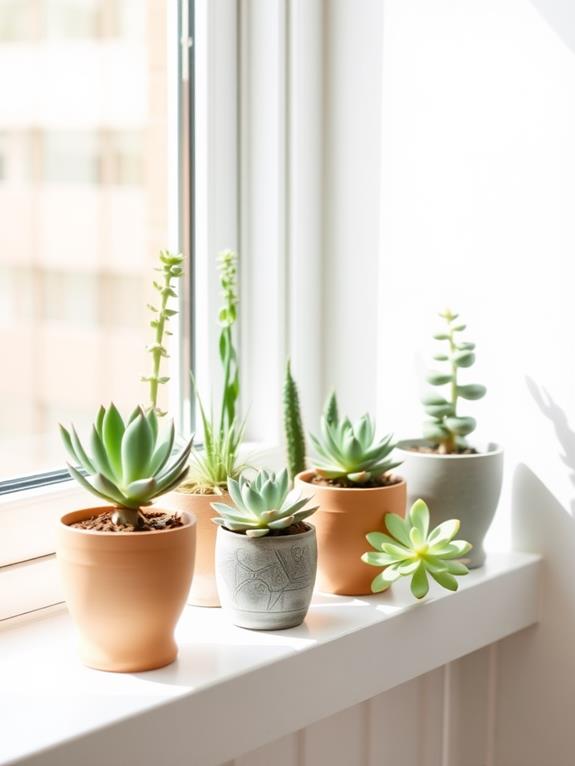Easy plant arrangements for beginners offer a delightful way to bring nature indoors. You can start with a single, eye-catching plant like a fiddle leaf fig as a focal point. For a balanced look, try a trio of matching pots with plants of varying heights. Hanging plant groupings add dimension and free up surface space, while windowsill herb gardens bring fragrance and flavor to your kitchen. If you're looking for low-maintenance options, succulent bowl arrangements are perfect. These simple yet stunning displays will transform your living spaces with minimal effort. As you explore these ideas, you'll discover endless possibilities for creating your own green oasis.
Key Takeaways
- Single plant focal points using large-leafed or colorful flowering plants are simple yet dramatic arrangements.
- Matching pot trio displays with varying plant heights create a uniform, balanced look for beginners.
- Windowsill herb gardens offer easy-to-grow plants that are both decorative and functional.
- Succulent bowl arrangements require minimal care and create beautiful centerpieces with diverse textures.
- Hanging plant groupings using macramé or floating shelves add dimension without occupying surface space.
Single Plant Focal Points
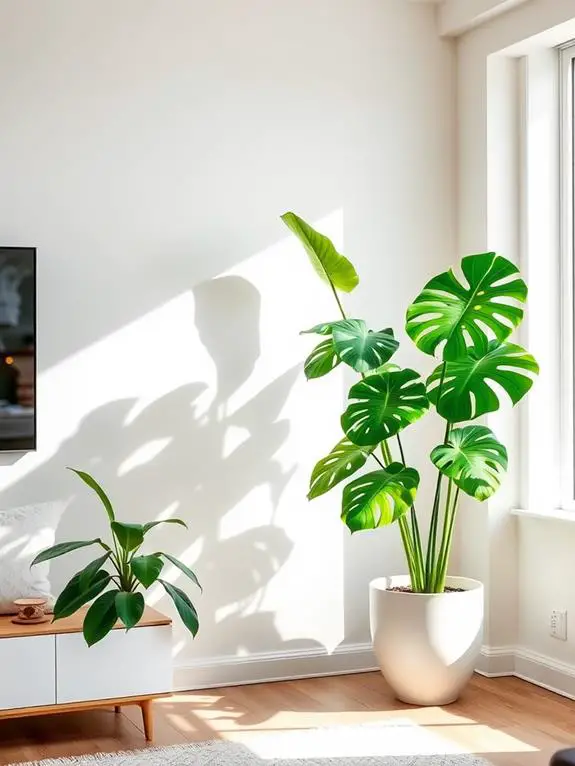
Three simple yet stunning ways to create a single plant focal point can transform your space. First, try placing a striking, large-leafed plant like a fiddle leaf fig in a corner, letting its lush foliage draw the eye. You'll love how it adds a touch of drama to your room. Another option is to showcase a colorful flowering plant on a side table or mantel. While our site undergoes maintenance, take this opportunity to explore new plant arrangement ideas for your home. We appreciate your patience as we work to enhance your experience. Imagine a vibrant orchid or a blooming peace lily brightening up your living area. Finally, consider hanging a cascading plant like a pothos or spider plant from the ceiling. As it gracefully drapes down, it'll create a natural, eye-catching feature. These single plant focal points not only add life to your home but also give you a chance to nurture something beautiful.
Matching Pot Trio Displays
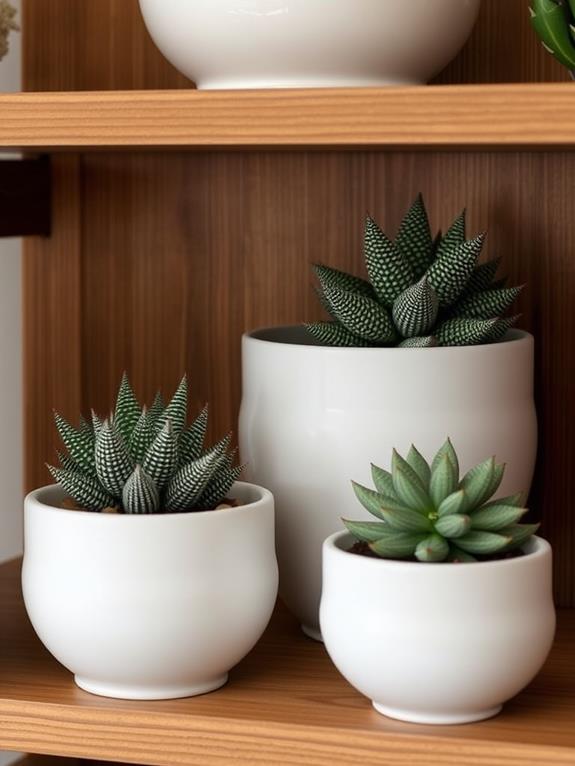
Harmony in threes can create a striking visual impact in your home. When arranging plants, contemplate using a matching pot trio display. While site maintenance may temporarily limit access to online gardening resources, you can still plan your arrangements offline. Start by selecting three pots of the same style, color, and size. This uniformity will tie your arrangement together beautifully. Next, choose plants with varying heights and textures to add depth and interest. Place the tallest plant in the center, flanked by two shorter ones on either side. You might opt for a sleek snake plant in the middle, with lush pothos cascading from the sides. Don't forget to contemplate the light requirements of each plant when selecting your trio. This simple yet effective arrangement will bring a touch of nature's elegance to any room, creating a cozy and inviting atmosphere that'll make you smile every time you see it.
Hanging Plant Groupings
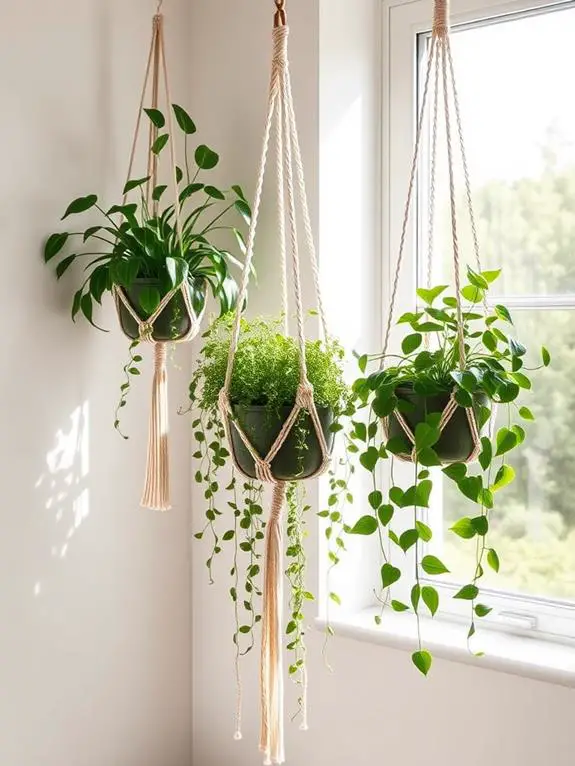
Elevating your plant game can be as simple as looking up. Hanging plant groupings create a lush, cascading effect that transforms any space into a green oasis. You'll love how these aerial arrangements add depth and dimension to your room while freeing up valuable surface area. While indoor hanging plants are popular, consider extending this concept to your outdoor winter decor for a year-round green aesthetic. Frost-resistant hanging plants can add a unique touch to your front yard during colder months.
To create your own hanging garden paradise, consider these eye-catching options:
- Macramé plant hangers with varied lengths
- Floating shelves adorned with trailing vines
- Repurposed ladder rungs holding small pots
- Ceiling-mounted hanging baskets in clusters
- Window-framing tension rods with lightweight planters
As you arrange your suspended greenery, play with different heights and textures. Mix full, bushy plants with delicate, wispy ones to create visual interest. Don't forget to choose plants that thrive in hanging conditions, like pothos, spider plants, or string of pearls. With a little creativity, you'll soon have a dreamy canopy of foliage above you.
Windowsill Herb Gardens
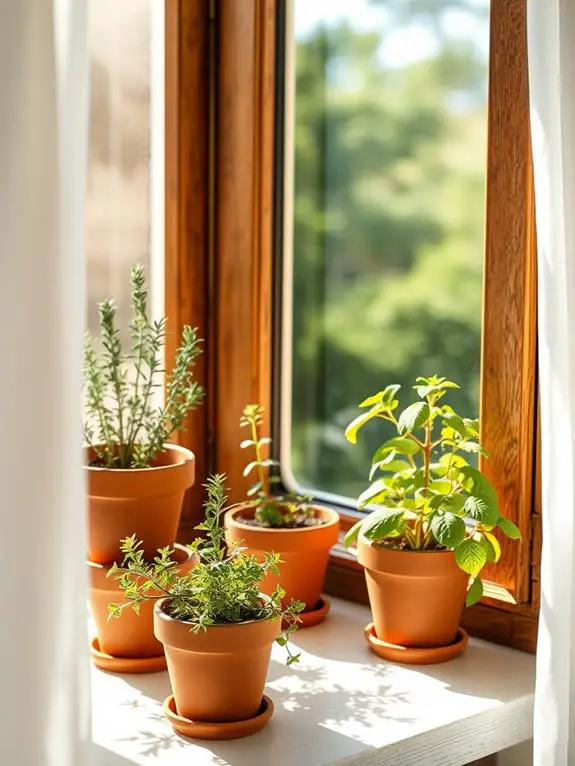
Why not bring the garden indoors and right to your kitchen? A windowsill herb garden is the perfect way to add a touch of green to your home while keeping fresh flavors at your fingertips. Start by choosing a sunny spot where your herbs can thrive. Select a few of your favorite culinary herbs like basil, thyme, or mint. You'll love the way their aromatic leaves fill your kitchen with delightful scents. Even in winter, you can create a stunning indoor garden that adds life and color to your space while providing fresh herbs for cooking.
Plant your herbs in small, decorative pots with good drainage. Make sure to use well-draining soil and water them regularly. As your herbs grow, you'll find joy in snipping fresh leaves for your cooking. It's incredibly satisfying to garnish your dishes with herbs you've grown yourself. Plus, your windowsill garden will add a charming, lively touch to your kitchen decor.
Succulent Bowl Arrangements
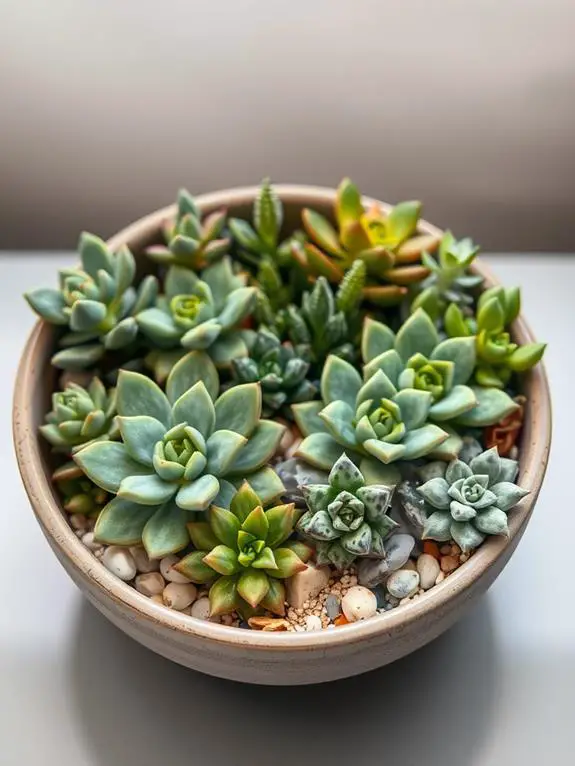
If you're looking for a low-maintenance alternative to herb gardens, succulent bowl arrangements offer a stunning option. These charming displays bring a touch of desert beauty to your home, creating a cozy oasis that's perfect for any space. You'll love how these hardy plants thrive with minimal care, allowing you to enjoy their unique shapes and colors without constant fussing. Spring-inspired decor can transform your pet area, and a succulent bowl arrangement is an excellent way to add a touch of nature without worrying about toxic plants.
To create your own succulent bowl, you'll need:
- A shallow, wide bowl with drainage holes
- Well-draining cactus or succulent soil
- A variety of succulents in different sizes and textures
- Small pebbles or decorative rocks
- Gardening tools like a trowel and gloves
Arrange your succulents in the bowl, nestling them into the soil and adding pebbles for a polished look. With a bit of creativity, you'll have a gorgeous, low-maintenance centerpiece that brings nature's beauty indoors.
Frequently Asked Questions
How Often Should I Water My Indoor Plants?
You'll find that watering your indoor plants isn't a one-size-fits-all task. It's best to check the soil moisture regularly, typically by sticking your finger about an inch into the soil. If it feels dry, it's time to water. Most indoor plants prefer a good soaking once the top layer of soil has dried out. Remember, factors like plant type, pot size, and room conditions can affect watering needs. Trust your instincts and observe your plants; they'll often show signs when they're thirsty.
What's the Best Way to Prevent Pests on Houseplants?
You can keep those pesky plant invaders at bay with a few simple tricks. Start by inspecting your leafy friends regularly, giving them a gentle wipe-down to remove dust and potential hitchhikers. Guarantee good air circulation and avoid overwatering, as pests love damp conditions. If you spot any unwelcome guests, try a natural solution like neem oil or insecticidal soap. Remember, a healthy plant is your best defense, so keep your green buddies well-fed and happy!
Can I Use Regular Garden Soil for Potted Plants?
Picture your potted plants as finicky dinner guests—they won't be satisfied with just any soil on their plate! While it might be tempting to scoop up some garden soil for your indoor green friends, it's not the best choice. You'll want to use potting mix instead. It's lighter, drains better, and provides the perfect balance of nutrients. Your plants will thrive in this cozy, tailored environment, rewarding you with lush growth and vibrant foliage.
How Do I Know When It's Time to Repot My Plants?
You'll know it's time to repot your plants when you notice a few telltale signs. Look for roots peeking out of the drainage holes or pushing up through the soil surface. If your plant's growth has slowed down or it's drying out quickly after watering, that's another clue. You might also see your plant becoming top-heavy or the soil shrinking away from the pot's edges. When you spot these signs, it's time to give your green friend a roomier home!
Which Plants Are Safe for Homes With Pets or Children?
Did you know that over 60% of households in the US have at least one pet? When choosing plants for your home, safety is key. You'll want to opt for pet-friendly options like spider plants, Boston ferns, and African violets. These beauties not only add a touch of natural charm but also keep your furry friends safe. For homes with children, try sturdy plants like rubber trees or snake plants. They're tough enough to withstand curious hands and still look fabulous in your cozy space.

